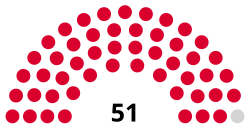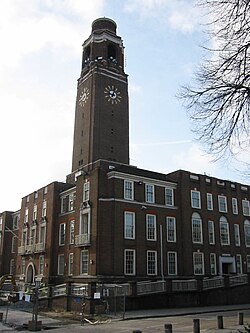Barking and Dagenham London Borough Council
 From Wikipedia - Reading time: 9 min
From Wikipedia - Reading time: 9 min
Barking and Dagenham Council | |
|---|---|
 | |
 Council logo | |
| Type | |
| Type | |
| History | |
| Founded | 1 April 1965 |
| Leadership | |
Fiona Taylor since April 2022[3] | |
| Structure | |
| Seats | 51 councillors |
 | |
Political groups |
|
Joint committees | East London Waste Authority Thames Chase Joint Committee Thames Gateway London Partnership London Councils |
| Elections | |
| Plurality | |
Last election | 5 May 2022 |
Next election | 7 May 2026 |
| Meeting place | |
 | |
| Town Hall, 1 Town Square, Barking, IG11 7LU | |
| Website | |
| www | |
| Constitution | |
| The Council Constitution | |
Barking and Dagenham London Borough Council, also known as Barking and Dagenham Council, is the local authority for the London Borough of Barking and Dagenham in Greater London, England. It is a London borough council, one of 32 in the United Kingdom capital of London. It provides a broad range of local government services including Council Tax billing, libraries, social services, processing planning applications, waste collection and disposal, and it is a local education authority. The council has been under Labour majority control since its creation in 1965. The council was created by the London Government Act 1963 as the Barking London Borough Council and replaced two local authorities: Barking Borough Council and Dagenham Borough Council. The council was renamed on 1 January 1980. It is based at Barking Town Hall in the centre of Barking.
History
[edit]The London Borough of Barking (as it was originally named) and its council were created under the London Government Act 1963, with the first election held in 1964. For its first year the council acted as a shadow authority alongside the area's two outgoing authorities, being the borough councils of Dagenham and Barking. The new council formally came into its powers on 1 April 1965, at which point the old districts and their councils were abolished.[4]
The pre-1965 borough of Barking had evolved from the Barking Town local government district, which had been created in 1882 covering the central part of the parish of Barking. The district was governed by an elected local board. Such districts were reconstituted as urban districts under the Local Government Act 1894, which saw the board replaced by an urban district council.[5][6] The Barking Town Urban District was incorporated to become a municipal borough in 1931, at which point the name was changed from Barking Town to Barking.[7][8] Neighbouring Dagenham was a rural parish with a parish council from 1894, subordinate to the Romford Rural District Council. In 1926 the parish council was replaced when Dagenham was made an urban district; it was made a municipal borough in 1938.[9][10]
The council changed the London borough's name from 'Barking' to 'Barking and Dagenham' with effect from 1 January 1980.[11] Since then the council's full legal name has been 'The Mayor and Burgesses of the London Borough of Barking and Dagenham'.[12]
From 1965 until 1986 the council was a lower-tier authority, with upper-tier functions provided by the Greater London Council. The split of powers and functions meant that the Greater London Council was responsible for "wide area" services such as fire, ambulance, flood prevention, and refuse disposal; with the borough councils (including Barking and Dagenham) responsible for "personal" services such as social care, libraries, cemeteries and refuse collection. As an outer London borough council Barking and Dagenham has been a local education authority since 1965. The Greater London Council was abolished in 1986 and its functions passed to the London Boroughs, with some services provided through joint committees.[13]
Since 2000 the Greater London Authority has taken some responsibility for highways and planning control from the council, but within the English local government system the council remains a "most purpose" authority in terms of the available range of powers and functions.[14]
Powers and functions
[edit]The local authority derives its powers and functions from the London Government Act 1963 and subsequent legislation, and has the powers and functions of a London borough council. It sets council tax and as a billing authority also collects precepts for Greater London Authority functions and business rates.[15] It sets planning policies which complement Greater London Authority and national policies, and decides on almost all planning applications accordingly. It is a local education authority and is also responsible for council housing, social services, libraries, waste collection and disposal, traffic, and most roads and environmental health.[16]
Political control
[edit]The first election was held in 1964, initially operating as a shadow authority alongside the outgoing authorities until it came into its powers on 1 April 1965. Labour have held a majority of the seats on the council since its creation.[17][18][19][20]
| Party in control | Years | |
|---|---|---|
| Labour | 1965–present | |
Leadership
[edit]Political leadership is provided by the leader of the council. The role of mayor is largely ceremonial in Barking and Dagenham. The leaders since 1965 have been:[21][22]
| Councillor | Party | From | To | |
|---|---|---|---|---|
| Ted Ball | Labour | 1965 | 1972 | |
| Joe Butler | Labour | 1972 | 1986 | |
| George Brooker | Labour | 1986 | 1998 | |
| Charles Fairbrass | Labour | 1998 | 13 May 2009 | |
| Liam Smith | Labour | 13 May 2009 | 12 Jun 2014 | |
| Darren Rodwell | Labour | 12 Jun 2014 | 18 Sep 2024 | |
| Dominic Twomey | Labour | 18 Sep 2024[23] | ||
Elections
[edit]Since the last boundary changes in 2022 the council has comprised 51 councillors representing 19 wards, with each ward electing two or three councillors. Elections are held every four years.[24]
Following the 2022 election and a subsequent change of allegiance in December 2022, the composition of the council was:[25][26]
| Party | Councillors | |
|---|---|---|
| Labour | 50 | |
| Independent | 1 | |
| Total | 51 | |
By-elections are scheduled for 28 November 2024 to replace Darren Rodwell (Abbey) and Margaret Mullane (Village) who resigned, and Lee Waker (Village) who died.[27] The next full election is due in 2026.
Premises
[edit]The council is based at Barking Town Hall in Town Square.[28] The building was purpose-built for the old Barking Borough Council and was completed in 1958.[29]

The council also inherited from the old Dagenham Borough Council the Civic Centre, which had been built in 1936, in the Becontree Heath area of Dagenham.[30] After the council consolidated its functions at Barking Town Hall, the Dagenham building was disused by the council in 2017 and converted to become a campus of CU London, a higher education institute run by Coventry University.[31]
References
[edit]- ^ "Council meeting, 17 May 2024". Barking and Dagenham Council. Retrieved 19 May 2024.
- ^ "Council minutes, 12 June 2014". Barking and Dagenham Council. Retrieved 17 July 2023.
- ^ "Fiona Taylor appointed as Chief Executive at Barking and Dagenham Council". Barking and Dagenham Council. 3 May 2023. Retrieved 17 July 2023.
- ^ "London Government Act 1963", legislation.gov.uk, The National Archives, 1978 c. 33, retrieved 16 May 2024
- ^ Kelly's Directory of Essex. 1914. p. 33. Retrieved 17 May 2024.
- ^ "Local Government Act 1894", legislation.gov.uk, The National Archives, 1894 c. 73, retrieved 12 April 2024
- ^ "Barking Urban District / Municipal Borough". A Vision of Britain through Time. GB Historical GIS / University of Portsmouth. Retrieved 17 May 2024.
- ^ A History of the County of Essex: Volume 5. London: Victoria County History. 1966. pp. 219–222. Retrieved 1 May 2024.
- ^ "Dagenham Urban District / Municipal Borough". A Vision of Britain through Time. GB Historical GIS / University of Portsmouth. Retrieved 1 May 2024.
- ^ Youngs, Frederic (1979). Guide to the Local Administrative Units of England. Vol. I: Southern England. London: Royal Historical Society. ISBN 0-901050-67-9.
- ^ Alteration of areas and status of local authorities 1980–1982 (PDF). London: Department of the Environment. 1982. p. 1729. Retrieved 16 May 2024.
- ^ "Inter Authority Agreement for the Local London Partnership Programme" (PDF). Havering Council. 2023. Retrieved 9 April 2024.
- ^ "Local Government Act 1985", legislation.gov.uk, The National Archives, 1985 c. 51, retrieved 5 April 2024
- ^ Leach, Steve (1998). Local Government Reorganisation: The Review and its Aftermath. Routledge. p. 107. ISBN 978-0714648590.
- ^ "Council Tax and Business Rates Billing Authorities". Council Tax Rates. Retrieved 8 April 2020.
- ^ "Local Plan Responses – within and outside London". Mayor of London. 12 November 2015. Retrieved 9 April 2020.
- ^ "Compositions calculator". The Elections Centre. 4 March 2016. Retrieved 3 March 2023.
- ^ "London Borough of Barking & Dagenham Election Results 1964-2010" (PDF). Elections Centre. Plymouth University. Retrieved 19 May 2018.
- ^ "London Borough Council Elections 23 May 2014" (PDF). London Datastore. London Residuary Body. Retrieved 19 November 2019.
- ^ "London Borough Council Elections 3 May 2018" (PDF). London Datastore. London Residuary Body. Retrieved 29 December 2019.
- ^ "Council minutes". Barking and Dagenham Council. Retrieved 10 July 2022.
- ^ "London Boroughs Political Almanac". London Councils. Retrieved 10 July 2022.
- ^ Reporter, Ruby Gregory | Local Democracy (19 September 2024). "New council leader revealed for Barking and Dagenham".
{{cite web}}: CS1 maint: multiple names: authors list (link) CS1 maint: numeric names: authors list (link) - ^ "The London Borough of Barking and Dagenham (Electoral Changes) Order 2021", legislation.gov.uk, The National Archives, SI 2021/1, retrieved 30 April 2024
- ^ "Election results by wards". London Borough of Barking and Dagenham. Retrieved 6 May 2022.
- ^ Boothroyd, David (16 December 2022). "When in Rome, do as the Andoverians do". Local Councils. Thorncliffe. Retrieved 17 July 2023.
- ^ "x.com".
- ^ "Contact us". Barking and Dagenham Council. Retrieved 30 April 2024.
- ^ Howard, Vic. "A Town Hall Mystery". Barking and District Historical Society. Retrieved 25 April 2020.
- ^ Historic England. "Former main building and council chamber of Dagenham Civic Centre (Grade II) (1064422)". National Heritage List for England. Retrieved 16 May 2024.
- ^ Murphy-Bates, Sebastian (6 February 2017). "Civic Centre's £4.5 million overhaul makes way for Dagenham university site". Barking and Dagenham Post. Retrieved 16 May 2024.
 KSF
KSF